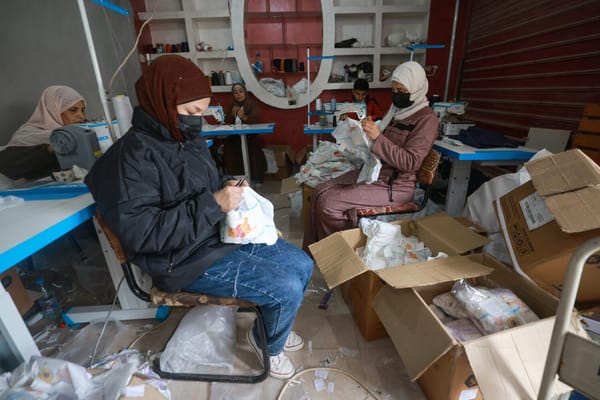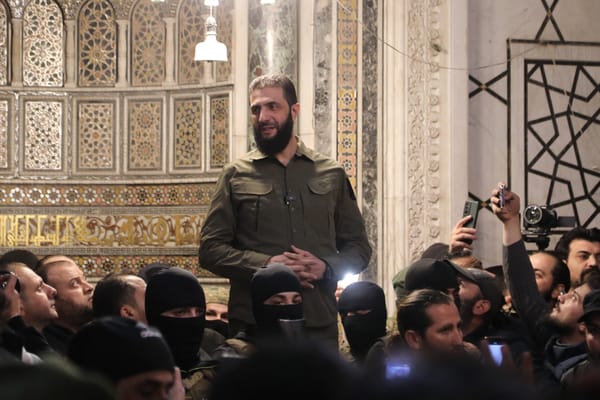Israel Is Waging War on Palestinian Prisoners
Behind the systematic torture and sexual violence in Israeli prisons, from MER's fall issue, 'Carceral Realities and Freedom Dreams."
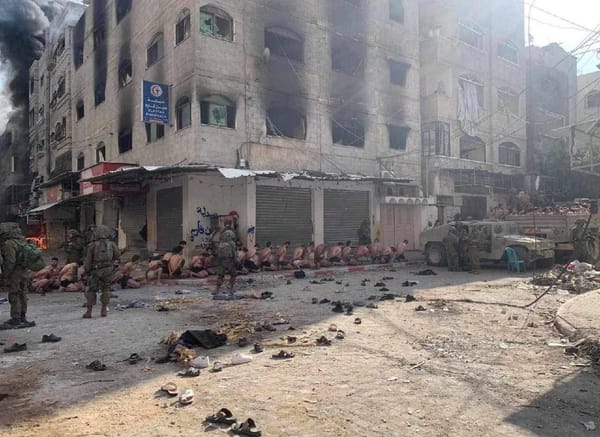

Behind the systematic torture and sexual violence in Israeli prisons, from MER's fall issue, 'Carceral Realities and Freedom Dreams."

Since October 7, 2023, conditions in Israeli prisons have paralleled the besieging and retaliatory war on the people of Gaza. But the heightened aggression against Palestinian prisoners started almost one year earlier.

In December 2022, Itamar Ben-Gvir, the leader of the ultra-nationalist, anti-Arab Otzma Yehudit (Jewish Power), became Minister of National Security, giving him control of the police and the Israel Prison Service (IPS).
“[O]ne of the highest goals I have set for myself,” Ben-Gvir declared, “is to worsen the conditions of the terrorists in the prisons, and to reduce their rights to the minimum required by law.”[1] He immediately began instituting numerous cruel measures to shrink Palestinian prisoners’ already scant resources and elevate their suffering. In February 2023, he set a four-minute limit on shower time and bragged in a TikTok post about closing the prisoner-run bakeries in Ketziot and Nafha while he waved a fistful of pita at the camera. In August, over 1,000 prisoners—one-fifth of Palestinians incarcerated at the time—declared a hunger strike to protest their dire situation. Ben-Gvir retaliated by reducing family visits to one every two months.
When the hot war started in October, the treatment of Palestinian prisoners deteriorated precipitously. Like the siege Israel imposed on Gaza, the IPS drastically reduced access to water and electricity. Food allocations were cut to a “minimal menu,” which, coupled with the shuttering of prison canteens, amounted to a starvation policy.[2] Soldiers and guards rampaged through compounds assaulting prisoners and firing rubber bullets and tear gas. Cell blocks were raided and most items were seized, including letters, books, medicine and radios. Many prisoners were moved to isolation and others were crammed into cells designed for five or six that were now made to hold 12 or more.
The IPS imposed a complete ban on visits by monitors from the International Committee of the Red Cross as well as family members. Phone calls to relatives became impossible and lawyers’ access to clients was halted for months and now remains severely restricted. As a result, Palestinian prisoners were isolated from most contact with the outside world. This combination of brutality, deprivation and communication blackout reproduced conditions of confinement in the first decade of the Israeli occupation of Gaza and the West Bank when prisons were unmonitored legal black holes.
This combination of brutality, deprivation and communication blackout reproduced conditions of confinement in the first decade of the Israeli occupation of Gaza and the West Bank when prisons were unmonitored legal black holes.
Interrogators dispensed with “moderate physical pressure”—the Israeli euphemism for its torture tactics—in favor of the crudest forms of physical violence, including beatings, protracted shackling in painful positions, suffocation and sexual assault.[3] Brute violence became endemic throughout every prison and detention center. Since October 7, at least 60 Palestinians died or were killed in Israeli custody, a figure that does not include an unknown number of Palestinians from Gaza whose reported deaths in military facilities are unconfirmed.
The war inside Israeli prisons has been fueled by escalating arrest campaigns across historic Palestine. On October 6, Israeli prisons held 5,200 Palestinians. In the months since, these numbers have skyrocketed. More than 10,000 Gazan workers and patients who were legally in Israel on October 7 were taken into custody. According to a July 2024 report by the UN High Commissioner for Human Rights: “It is estimated that 3,200 of them were released and transferred into Gaza in November 2023, 6,441 were transferred to [detention facilities in] the occupied West Bank, while around 1,000 of them remain unaccounted for.”[4]
In the context of the ground invasion, thousands—including humanitarian workers, women, children, disabled and elderly people—were swept up in indiscriminate capture operations and transferred out of the occupied Gaza Strip. The World Health Organization and other monitoring agencies report that at least 310 healthcare workers, patients and their companions were taken into custody from hospitals and clinics when Israeli forces attacked the facilities. Adnan al-Bursh, the head of orthopedics at al-Shifa Hospital, was detained while working at al-Awda Hospital. He was tortured to death on April 19.
In the West Bank, more than 9,000 Palestinians were arrested between October and early June 2024. Inside the Green Line, 200 Palestinian citizens were arrested, mostly on suspicions of “incitement to terrorism” and “identifying with terror organizations” for expressing opposition to the war and condemnation of its human toll.[5]
According to HaMoked, an Israeli human rights and legal-aid organization, as of August 2024, 9,881 Palestinians were imprisoned, either as “security prisoners”—those who have been convicted or are under investigation or remanded for trial —or as “security detainees” who are administratively detained without charges. Another 1,584 Palestinians from Gaza are being held incommunicado. Addameer, a Palestinian prisoner support and human rights association, reports that the prisoner population includes 250 children, 86 women and 12 Palestinian Legislative Council members.
In the current moment—as Israel’s genocidal war on Gaza has killed tens of thousands, and military assaults and state-supported settler pogroms are rampant across the West Bank—the level and scope of violence and dehumanization perpetrated by Israeli soldiers, security agents and IPS staff against detainees and prisoners has extended the hot war into prisons.
Palestinians who were released from custody in recent months have emerged emaciated, bruised and deeply scarred from tight cuffing. Their testimonies provide glimpses into the abyss.
Omar Assaf, 74, was arrested in Ramallah in October 2023 and administratively detained for six months in Ofer prison in the West Bank. When he was released in April, before-and-after photos were posted on social media; the “after” reveals that he had lost 60 pounds, and his hair had turned white. At a gathering to welcome Assaf home, he described the contrast between what he endured during previous periods of imprisonment over the past four decades and the present. “The conditions inside Israeli prisons today are unprecedented,” he said.[6]
Moazaz Obayat, 37, was released in July 2024 following nine months of administrative detention. A video circulated online shows Obayat—once a muscular bodybuilder—so frail he was unable to walk out of the prison without assistance. His right arm and leg appear paralyzed or broken and his face shows clear signs of starvation. Speaking to the camera, he says, “On December 4, I was subjected to an attempted murder in Ofer prison. Ben-Gvir danced on top of my body. The situation is extremely dire. We are dying every day.”[7] In another clip recorded in the hospital where Obayat was taken for treatment, he says, “Naqab prison is like Guantánamo. There is killing, beating, starvation, poverty and illness. Two thousand prisoners are suffering from chronic diseases, very chronic diseases, very severe diseases. Their conditions are extremely bad. They only have Allah.” He adds, “I was released, but why didn’t we die together?”[8]
Prisoners requiring medical care—whether for new injuries or chronic diseases—have been denied access to prison clinics and outside hospitals, and those needing prescribed medicines and treatments have been cut off.
Prisoners requiring medical care—whether for new injuries or chronic diseases—have been denied access to prison clinics and outside hospitals, and those needing prescribed medicines and treatments have been cut off. These developments exacerbate the long-practiced policy of medical negligence by the IPS and complicit medical professionals. A West Bank man released in June from Ramon prison said there appears to be a standing order to “call on the guards only when prisoners die.”[9] One of many tragic examples of medical negligence was Arafat Hamdan, 25, a diabetic whose cellmates pleaded with guards to give him insulin or even a spoonful of sugar to no avail. Two days after his arrest, he was beaten and placed outside, under the sun, with a bag on his head for hours before he died.
Getting details of the prisoners’ conditions is difficult because of the communication blackout. Israeli authorities allow one member of a prisoner’s family to attend court sessions, which prisoners join through video conference. These sessions have become the only way for families to communicate with their loved ones, albeit for a few minutes. At a hearing in the Ofer military court on March 27, 2024, a prisoner started telling the judge that he was severely beaten by the IPS’s Nahshon, the unit in charge of transporting prisoners between prisons and to court. “I just tried to cover my head when they were beating us,” he said before being silenced by a screaming guard. Another described the violent treatment he received while being transported as a “continuation of interrogational torture through other means.”[10]
Israel’s war inside its prisons is not directed only against those captured since October. Long-term prisoners have been equally affected by the vengeance policy of heightened violence and inhumane deprivations. On December 21, 2023, Thaer Abu Assab, who was imprisoned in Ketziot for 18 years, asked a guard whether there was a ceasefire. The guard said, “I’ll show you.”[11] Then 19 guards entered Abu Assab’s cell and beat him to death with iron rods.
Marwan Barghouti, a popular political figure who has spent 24 years in prison, suffered a dislocated shoulder—untreated—when he was dragged with his hands cuffed behind his back to an isolation cell where he was beaten unconscious. According to his lawyer, Igal Dotan, “He’s struggling to see out of his right eye, as a result of one of the assaults.”[12] Dotan also commented on Barghouti’s dramatic weight loss: “You wouldn’t recognise him if you compare his current appearance with the famous photos of him.” In December, after Barghouti was transferred to Ayalon prison, he was “dragged on the floor naked in front of other prisoners.”[13]
Read: Two Essays by Palestinian Political Prisoner, Walid Daqqah.
Walid Daqqah, a Palestinian citizen widely respected for his literary and social-philosophical writings, was incarcerated for 38 years. In 2022, he was diagnosed with a rare form of cancer that would require a bone marrow transfusion. Daqqah died in prison on April 7, 2024, after the IPS refused him medical care and courts rejected petitions from his family for compassionate release in his last days. His body, like dozens of others who died in custody, remains imprisoned by the Israeli authorities for possible use as bargaining chips.
Euro-Mediterranean Human Rights Monitor interviewed approximately 100 Palestinians from Gaza who were detained and later released, including 22 women, four children and 17 elderly men. In a report released in May 2024, Euro-Med identified various forms of cruel, inhumane and degrading treatment and extra-judicial punishments, including strip searches and forced nudity; breaking bones and teeth; being stepped, spit and urinated on; punishment for praying and threats of rape and murder.
B’Tselem issued a report in August with testimonies from 55 released Palestinians. The litany of horrors match those reported by Euro-Med. B’Tselem concluded that Israeli prisons and detention facilities, “in which every inmate is intentionally condemned to severe, relentless pain and suffering, operate as de-facto torture camps.”[14]
A deluge of photos and videos shot by Israeli soldiers and circulated on Telegram and other social media sites since October 7 have validated Palestinians’ first-person accounts of torture and abuse.
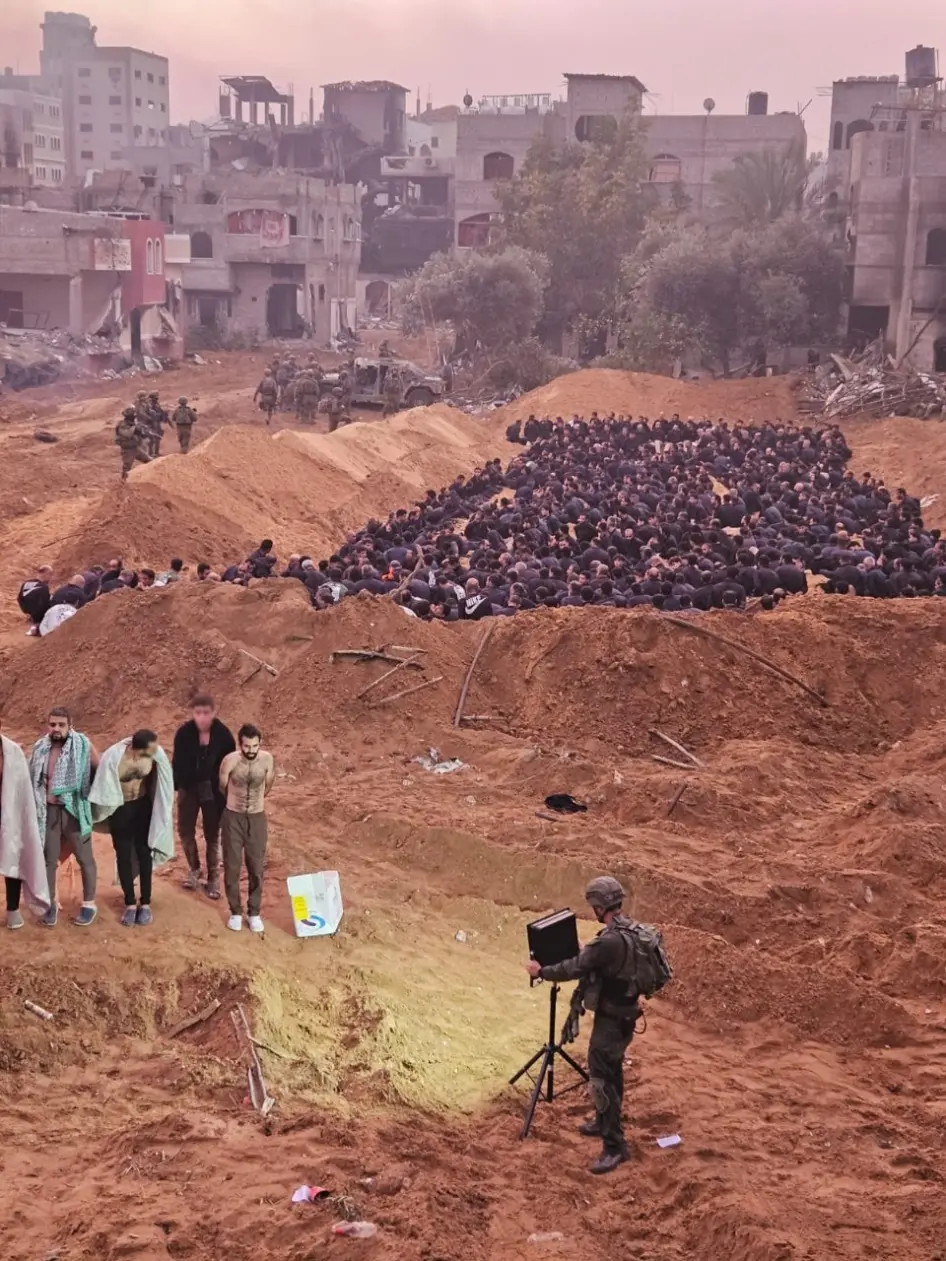
Some of the most horrendous Israeli-sourced images depict shirtless or naked detainees bound and blindfolded, being dragged across gravel and stomped and kicked in their heads and genitals. Soldiers’ decisions to publish images of themselves and their comrades humiliating and brutalizing Palestinians serve to amplify the unfettered violence that defines the present. The circulation of such images also serves as a form of “terroristic torture,” that is, making the torture of some publicly known in order to terrorize the broader targeted society.[15] In this case, the gruesome images are intended to threaten all Palestinians that resistance is not only futile but punishable by the most extreme measures, including maiming and death.
To manage the messaging about prison conditions while sating domestic Israeli appetites for more evidence of retribution against Palestinians, prison authorities have granted access to some reporters. A segment broadcast on Israel’s Channel 14 on February 2, 2024, shows an IPS officer matter-of-factly describing the abusive treatment being meted out in the facility. Panning to rows of prisoners sitting on the concrete floor of a courtyard with their heads bowed, he comments, “There are 150 prisoners here. None of them moves…until the shift supervisor approves it.”[16] As they tour several cells crammed with bowed and bound prisoners, the reporter comments, “What you see now is their daily routine. The days of summer camp are over.”
A segment broadcast on Channel 13 on February 18 begins with a scene of heavily armed guards wearing balaclavas and accompanied by a dog entering a cell as one screams, “Head on the floor!”[17] Another scene shows what the reporter refers to as a “secret wing” where prisoners are forced to kneel in the fetal position with their hands and feet cuffed at all times. The reporter comments on a nationalist song playing in the background: “This song ‘Am Yisrael Chai’ is heard in the wing, repeatedly, non-stop. The prison authorities claim that it is meant to boost the staff’s morale. But it is clear that this is another part of the psychological warfare against the prisoners.”
Photos and videos of Palestinians being tortured and abused have also been published in the foreign media. The condemnations and reproaches they have evoked are a source of consternation and concern for Israeli officials, who may have to contend with the threat that material evidence of torture will pose for them in the future. On June 26, Ronen Bar, director of the Shin Bet (Israel’s domestic intelligence agency), issued a warning letter to Prime Minister Benjamin Netanyahu and Ben-Gvir that the situation in prisons is a “time bomb” that could “endanger senior Israelis abroad and expose them to ‘international tribunals.’”[18] He elaborated: “Israel is having difficulty repelling claims against it, at least some of which are well founded.”
Prison conditions for Palestinians have always been grueling and severe, and torture is a durable feature of Israel’s carceral regime.
Following the 1967 occupation of the remainder of historic Palestine, torture became a central component in the trifecta of Israeli strategies of control through punishment, the other two being arrest and prosecution or detention without trial. Lacking other forms of evidence, the Israeli military courts depend on Palestinians’ confessions to secure convictions. The use of violence and coercion to elicit incriminating statements for legal proceedings has been a mainstay of interrogations and a key element of Israeli carceralism.
With the recommendations of the Landau Commission, the Israeli government acquired the ignominious distinction as the first state in the world to publicly proclaim the right to torture, albeit the authorized tactics were euphemized as “a moderate measure of physical pressure."
For two decades, Israel dismissed allegations of torture as enemy propaganda and lies. That changed in 1987 with the report by the Landau Commission, a state-established inquiry into possible wrongdoings by the Shin Bet. The Landau Commission validated long-denied accusations of systematic abuse while endorsing the Shin Bet’s contention that violent and coercive tactics were a necessary and vital part of the state’s fight against “hostile terrorist activity.”[19] This activity was broadly defined to include not only acts of violence but any resistance to the occupation—including speech—or assertions of Palestinian national rights. The Commission recommended that the government authorize these tactics to relieve Shin Bet agents from the need to lie to military judges when defense lawyers challenged confessions as coerced. With these recommendations, the Israeli government acquired the ignominious distinction as the first state in the world to publicly proclaim the right to torture, albeit the authorized tactics were euphemized as “a moderate measure of physical pressure.”[20] (In 2002, the US government emulated Israel’s rationales of necessity in an attempt to legalize its own torture program for the “war on terror.”)
In the early 1990s, responding to increased monitoring and reporting by human rights organizations, the Shin Bet largely shifted from the use of tactics that leave physical marks, like beatings and electric shocks, in favor of so-called clean techniques like protracted position abuse, isolation, sleep deprivation, shaking and confinement in refrigerated or overheated spaces. Such tactics are no less torturous, but they don’t leave scarring marks, making them easier to deny and thus, avoid accountability. Indeed, Israel has maintained a near-perfect record of impunity for torture. Out of 1,450 complaints of torture submitted to the Ministry of Justice between 2001 and 2022, three resulted in a criminal investigation with zero indictments.[21]
The Public Committee Against Torture in Israel (PCATI) and other Israeli human rights organizations challenged the government’s authorization of torture through lawsuits in the High Court of Justice (HCJ). In 1999, the HCJ ruled in PCATI et al v The State of Israel that certain interrogation tactics (such as painful shackling and protracted use of stress positions)—which the Court had not prohibited in the past—were illegal under Israeli and international law. The decision barred the routine use of such tactics, but it included a loophole enabling the use of coercion and violence if “security officials believe that a suspect is withholding information that could prevent an impending threat to civilian lives”—the so-called “ticking bomb" scenario.[22]
The landmark HCJ decision did not end the use of torture on Palestinians. But other events and developments altered the centrality of interrogation in Israeli control-and-punishment strategies. Soldiers had engaged in targeted killings of Palestinian suspects since at least 1988, but the government denied doing so because it is categorically illegal. The doing-and-denying ended in November 2000 when Israel again acquired the ignominious distinction as the first state in the world to publicly declare its right to extra-legally execute people. (The United States began engaging in targeted killing in 2002 and copied Israel’s reasoning in a 2010 memo to legally rationalize the practice.) The option to kill rather than capture Palestinian suspects downgraded the importance of arrest, interrogation and prosecution.
In 2002, Israel passed an Unlawful Combatants Law. The concept, although not new, had acquired international visibility in November 2001 when US President George W. Bush issued an executive order decreeing that anyone taken into US custody overseas in the context of the “war on terror” was an “unlawful enemy combatant.” This designation contravened the laws of war (i.e., the 1949 Geneva Conventions) in which every person is either a combatant or a civilian. The US objective in deploying this status category was to facilitate secret detention, but the ulterior motive was to enable the use of interrogation techniques that are prohibited and criminalized. According to the 2002 Israeli law, the unlawful combatant label could be applied to anyone who directly or indirectly participated in hostile acts against the State of Israel and was not entitled to prisoner-of-war status (copying US misinterpretations of the Geneva Conventions). The designation was applied mainly to foreign Arabs who already were being secretly detained (held incommunicado) and tortured in Israel.
On December 18, 2023, the Knesset amended the Unlawful Combatants Law to expand secret detention by enabling the military to hold people for 45 days without an arrest warrant or any oversight by a court. Under the amended law, detainees can be denied access to a lawyer for up to 75 days on the order of the prison official responsible for implementing the law, and courts can extend detention and denial of access to a lawyer for up to 180 days. As was the case in the US “war on terror," for Israel, holding people incommunicado provides cover for torture.
For Palestinians from Gaza, the IPS has made it impossible to meet a lawyer even when they have a right to do so. As Qadura Fares, head of the Palestinian Commission for Detainees and Ex-Detainees Affairs, explains, “Israeli prison authorities demand receiving a hard copy of a direct power of attorney made for the lawyer, and signed by the detainee’s relatives in Gaza, which is impossible: the lawyer will not access Gaza, and the families of the prisoners cannot enter Israel. Having a power of attorney sent by WhatsApp or email is not accepted by Israeli authorities, and so prisoners aren’t allowed legal presentation.”[23]
Sde Teiman, a military camp in the Negev desert, was partially converted into a detention center after the start of the war. It has been characterized as a “black site” because, not only is it inaccessible to independent monitors, but officials regard the identities and treatment of those held there to be a state secret. At least two military bases in the West Bank, Anatot and Ofer, also have had sections repurposed for secret detention.
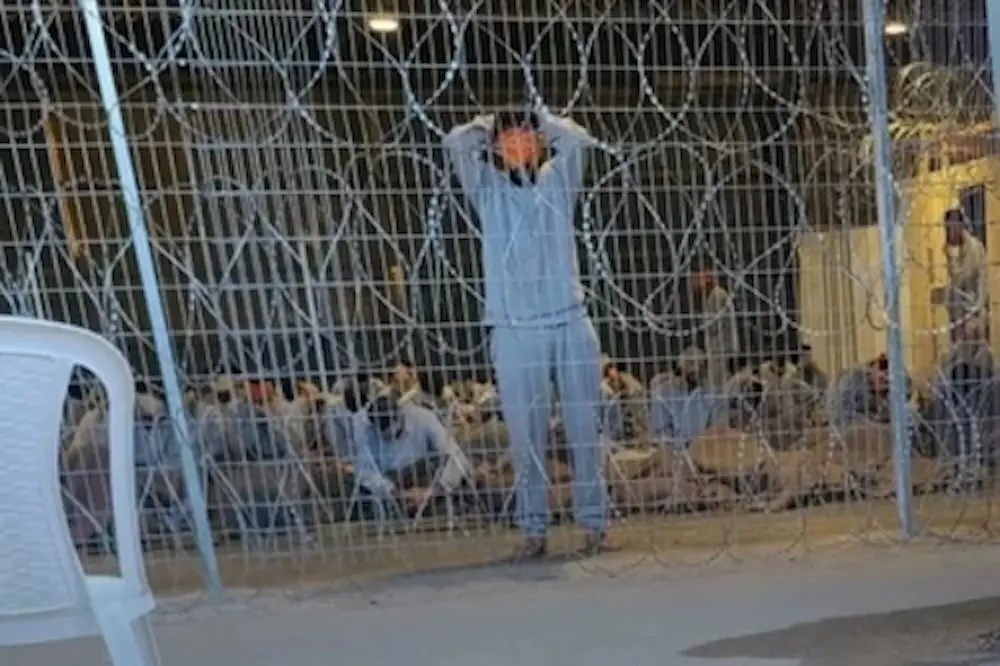
But the veil of secrecy shrouding Sde Teiman was lifted in April when Ha’aretz reported on a letter sent to Israeli cabinet members by a doctor working at the facility. “Just this week, two prisoners had their legs amputated due to handcuff injuries, which unfortunately is a routine event," the physician wrote. He added, “I am writing to warn you that the facilities’ operations do not comply with a single section among those dealing with health in the Incarceration of Unlawful Combatants Law."[24]
One month later, CNN published an explosive exposé about Sde Teiman based on accounts by three whistleblowing soldiers and 12 Gazans who recently were released. According to the whistleblowers, one section of the detention facility contains a large hangar surrounded by barbed wire where blindfolded Palestinians are shackled in stress positions for up to 16 hours a day. Detainees who talk, fall asleep or even move can be cuffed to the fence in a standing position with hands above their heads. At night, dogs have been released into prisoners’ cells while sound grenades are fired. The other section of the detention facility contains a field hospital where wounded Palestinians are shackled to beds, blindfolded, stripped of their clothes and forced to defecate in diapers. CNN reported that “doctors sometimes amputated prisoners’ limbs due to injuries sustained from constant handcuffing; of medical procedures sometimes performed by underqualified medics earning it a reputation for being ‘a paradise for interns’; and where the air is filled with the smell of neglected wounds left to rot.”[25]
Decisions by Israeli doctors to perform medical procedures on detainees without anesthesia is not due to shortages, as is the case for doctors in Gaza; it is a choice that comports with the retaliatory and illegal nature of the broader war. One informant told CNN: “I was asked to learn how to do things on the patients, performing minor medical procedures that are totally outside my expertise.”[26]
Khaled Mahajneh was the first lawyer the military permitted to visit Sde Teiman. He went to the facility on June 19 to meet with Mohammad Arab, an Al Araby TV journalist who was taken into custody in March while covering the Israeli attack on al-Shifa Hospital. In an interview with +972, Mahajneh said, “The situation there is more horrific than anything we’ve heard about Abu Ghraib and Guantánamo.”[27]
Amid plentiful accounts and abundant material evidence of systematic rape, torture and murder of Palestinian prisoners, in July, Major General Yifat Tomer-Yerushalmi, the military advocate general (MAG), moved forward on an investigation of a gang rape by nine soldiers at Sde Teiman. A Palestinian from Gaza, who was suspected of being a member of Hamas’s Nukhba unit, was so badly brutalized in the course of being sodomized that he suffered a ruptured bowel, severe damage to his anus, broken ribs and lung damage. (The assault was captured on a surveillance video.) He was transferred in critical condition to a nearby hospital where he required surgery. Dr. Yoel Donchin, who treated the raped detainee at Sde Teiman, told Ha’aretz that he was shocked an Israeli guard could do such a thing. “I was certain this was revenge by Nukhba against Nukhba.”[28] He added, “If the state and Knesset members think there’s no limit to how much you can abuse prisoners, they should kill them themselves, like the Nazis did, or close the hospitals…If they maintain a hospital only for the sake of defending ourselves at the Hague, that's no good.”[29]
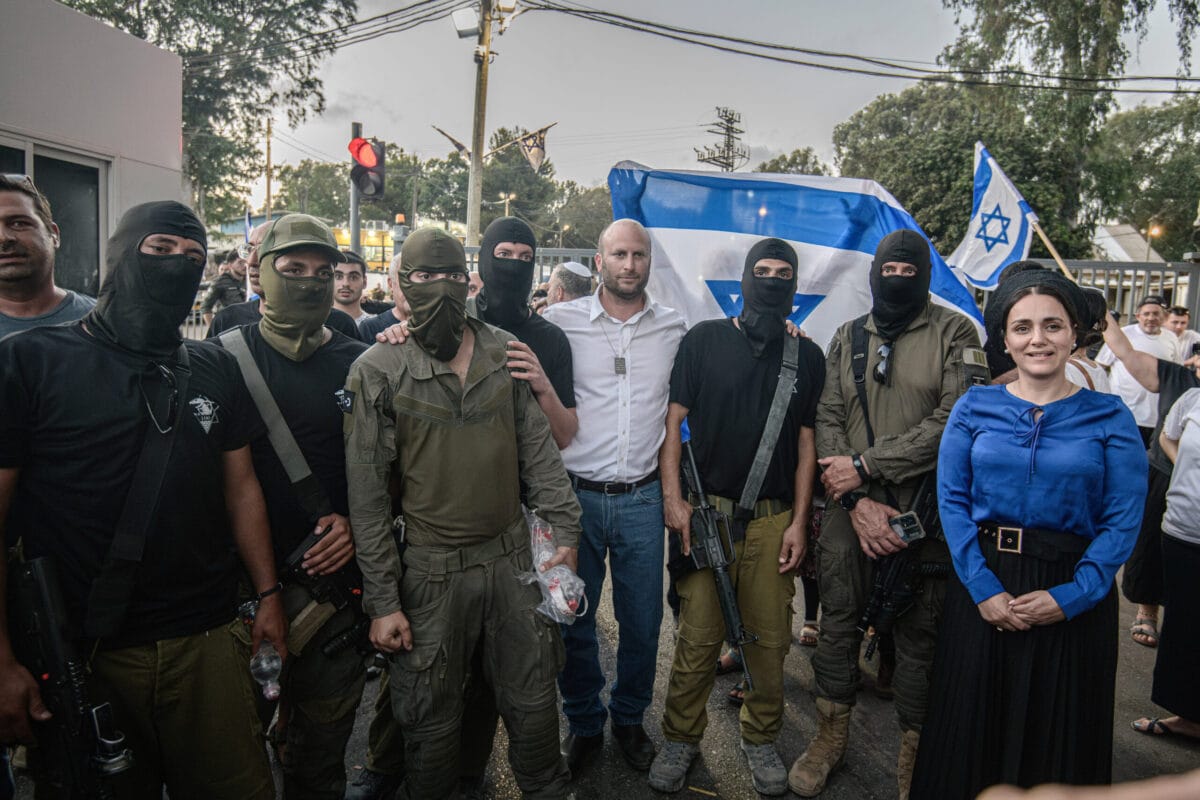
On July 29, military police were dispatched to Sde Teiman to take into custody the nine reservists accused of the gang rape; one of them is a major who commands Force 100, the unit tasked with guarding prisoners at Sde Teiman and other military detention facilities. Another reservist also wanted for multiple acts of aggravated abuse of prisoners was not on the base at the time. Soldiers from Force 100 resisted the military police in an attempt to prevent the arrests. Following shouting and clashes, they barricaded themselves along with the wanted suspects in a show of solidarity. During this standoff, a mob of about 200 Israelis, including some members of the Knesset, stormed the base to support the soldiers.
During this standoff, a mob of about 200 Israelis, including some members of the Knesset, stormed the base to support the soldiers.
As the riot at Sde Teiman was unfolding, there were debates in the Knesset over the MAG's move to investigate soldiers for gang rape. Likud member Yuli Edelstein, who chairs the Foreign Affairs and Defense Committee, said, “A situation where masked military police officers conduct a raid on an IDF base is not acceptable to me and I will not allow it to happen again. Our soldiers are not criminals and this disgraceful persecution of our soldiers is unacceptable to me.”[30] Ahmad Tibi, a member from Hadash Ta’al who was outraged by comments of other members, asked: “Is inserting an explosive into the rectum of a person legitimate?” Likud member Hanoch Milvetsky retorted, “If he is a Nukhba, everything is legitimate.”[31] Ben-Gvir chimed in that “the sight of military policemen arriving to arrest our best heroes in Sde Teiman is nothing short of shameful. I advise the Minister of Defense, the Chief of Staff and the army authorities to support the soldiers and to benefit from the Prison Service. The summer camp and tolerance for terrorists are over. Our soldiers must receive full support.”[32]
When the nine suspects finally were extricated from Sde Teiman, they were transferred to the base at Beit Lid for questioning. There, an even larger mob—including members of Force 100—stormed the base and rampaged to protest the arrest of soldiers accused of rape and aggravated abuse. On July 31, two of the suspects were released without charges and three more were released a week later. On August 22, the military prosecutor asked a court to continue the house arrest of the other five, who are still being investigated. The gang-raped detainee was reportedly returned to Sde Teiman on August 1.
Israel’s treatment of Palestinians is a decades-long evolving story but one never free of dehumanization and discrimination. Endemic torture and abuse of prisoners is only one dimension of the violent and degrading practices present in all spheres of Israeli control that affect Palestinians. Israel’s carceral project has been designed and implemented to eliminate Palestinians’ national-collective existence, to re-engineer the population through fragmentation and repression and to deter people from engaging in resistance or even aspiring to liberation. Indeed, as Walid Daqqah explained, there are the “small prisons,” where at least 800,000 Palestinians have been incarcerated over the decades, and the “large prison” of Palestinian society which, despite geographic and political fragmentation, remains unified by experiences of occupation and apartheid.[33]
Israel has strived in countless ways to permanently extinguish Palestinian dreams for freedom and liberation and has justified every measure in the name of security. For many Israelis, anything that can be framed as a security necessity, no matter how horrific or illegal, is acceptable, and for those on the right the more horrific the better. But the current war is taking its toll on the willingness of many foreign states, even close allies, to accede to Israeli security rationales that everything the government does to Palestinians is justifiable and necessary.
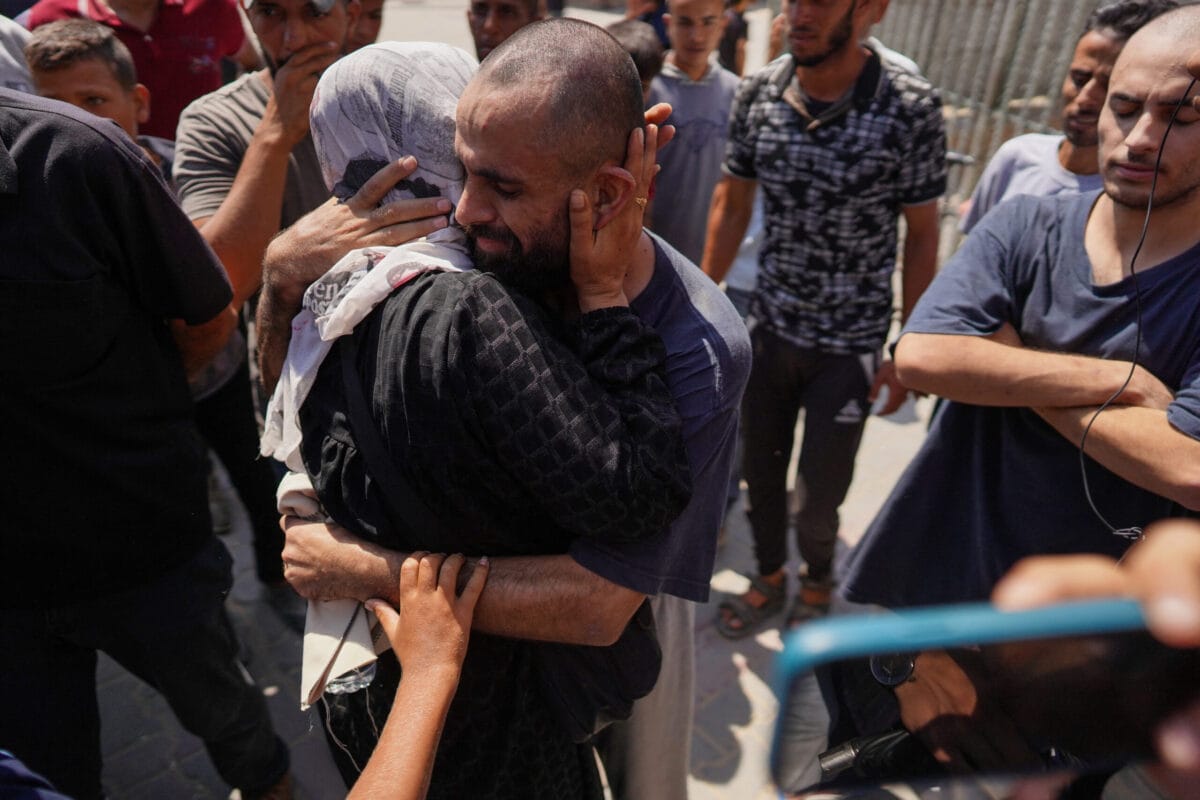
The war has triggered moves to bring the retributive power of law to bear on Israel. In December 2023, South Africa submitted an application to the International Court of Justice to institute proceedings against Israel for genocide in Gaza, and in January 2024, the ICJ issued a preliminary order finding the allegations plausible. In May, the chief prosecutor of the International Criminal Court applied for arrest warrants for Prime Minister Netanyahu and Defense Minister Yoav Gallant for various war crimes and crimes against humanity in connection with the war on Gaza. Whatever may come of these international-legal initiatives, they are significant in countering and assailing Israel’s everything-is-justifiable security narrative.
But it is torture specifically that may prove to be the Achille’s heel of Israel’s crimes against Palestinians. Genocide is notoriously difficult to prosecute because of the onerous intent requirement built into its definition. Proving war crimes poses its own challenges because the fog of war can obscure culpability. Crimes against humanity do not require proof of intent, but the scope and scale of what Israel has done to the people of Gaza—including mass killing, starvation, ethnic cleansing and total destruction of every vestige of life and society—may, by its very hugeness, be an impediment to accountability.
Compared to all other kinds of political violence and humanitarian violations, the clarity of the crime of torture lies in the fact that it is perpetrated against individuals in custody.
Compared to all other kinds of political violence and humanitarian violations, the clarity of the crime of torture lies in the fact that it is perpetrated against individuals in custody. International laws enshrine clear and universally binding constraints on a state’s prerogatives in its treatment of people in custodial settings. Moreover, every human being has the right not to be tortured without exception or caveat. And despite the global prevalence of torture, its illegality remains widely accepted. Indeed, the reason the Israeli and US governments have gone to such lengths to try to reinterpret the law to make their abuse of prisoners both legal and perceived as not torture (as evident in official insistence on obfuscating euphemisms like “moderate physical pressure” or “enhanced interrogation techniques”) is because they recognize that torture is a crime for which there is no legal justification, including war, national security or self-defense.
The unprecedented scale of the torture of Palestinians is one way Israel has sought retribution for the Hamas attacks of October 7. But exacting extra-legal retribution on prisoners is illegal because torture is absolutely prohibited under all circumstances and constitutes a gross crime under international law. Perpetrators can be subject to prosecution in international tribunals like the ICC or in foreign courts on the basis of universal jurisdiction.
Beyond the legal issues, torture maintains its reputation as an odious and abhorrent practice. As recent events at Sde Teiman laid bare, the exposure and undeniability of torture provoked a debate among Israelis that no other crime perpetrated against Palestinians since October had. The fact that the MAG’s decision to open a criminal investigation into a handful of soldiers accused of gang rape elicited pro-rape blowback offers a particularly stark example of consensus breakdown even within the military when it comes to torture. If Israel maintains its perfect record of impunity in the current period, those culpable for torture are—or can be made—vulnerable to retributive justice elsewhere.
[Lisa Hajjar is chair of the sociology department at the University of California, Santa Barbara. Basil Farraj is an assistant professor at the Department of Philosophy and Cultural studies, Birzeit University and an Arab Council for the Social Sciences (ACSS) Early Career Fellow.]
[1] Post by Itamar Ben-Gvir on X on July 2, 2024: https://x.com/itamarbengvir/status/1808031178277925263.
[2] Palestine Chronicle Staff, “‘Death Penalty a Solution’ – Ben-Gvir Adamant On Overcrowding in Israeli Prisons,” The Palestine Chronicle, July 2, 2024.
[3] "Key issues: torture and ill treatment," Addameer.
[4] "Detention in the context of the escalation of hostilities in Gaza (October 2023 – June 2024) – Thematic Report by OHCHR," United Nations, July 31, 2024.
[5] "Crackdown on Freedom of Speech of Palestinian Citizens of Israel," Adalah, October 23, 2023.
[6] Basil Farraj visited Omar Assaf following his release in April 2024.
[7] Anadolu English, "Moazaz Obayat released from Israeli prisons after 9 months in a ‘shocking’ health condition," YouTube, July 10, 2024.
[8] Ibid.
[9] This man, who wishes to remain anonymous, was interviewed by Farraj after his release in June 2024.
[10] Farraj, whose father is imprisoned, was able to attend a session in the Ofer military court on March 27 in which several prisoners appeared on the screen. 7
[11] Monjed Jadou, "‘Systematic torture’: To be Palestinian in an Israeli prison," Aljazeera, February 18, 2024.
[12] Ruth Michaelson, Sufian Taha and Quique Kierszenbaum, "Israeli abuse of jailed Palestinian leader Marwan Barghouti ‘amounts to torture,'" The Guardian, May 18, 2024.
[13] Ibid.
[14] B'Tselem report: "Welcome to Hell: The Israeli Prison System as a Network of Torture Camps," August 2024.
[15] Lisa Hajjar, Torture: A Sociology of Violence and Human Rights, (Routledge, 2013), p.23.
[16] Middle East Eye, “A segment from Channel 14 that explores one of Israel’s top security prisons for Palestinians,” YouTube, February 2, 2024.
[17] Jonathan Ofir, “Israel Channel 13 prison tour 18.2.2024,” YouTube, March 1, 2024.
[18] Yoav Zitun, "The full warning document of the head of the Shin Bet: All the dangers of the incarceration crisis," YNet, July 2, 2024. [Hebrew]
[19] State of Israel, "Commission of Inquiry into the Methods of Investigation of the General Security Service Regarding Hostile Terrorist Activity," (Jersalem, October 1987), p.
[20] Ibid, p. 80.
[21] PCATI, "Torture in Israel: Situation Report 2023.”
[22] “Torture under Occcupation,” Addameer, September 19, 2018.
[23] Mohamed Solaimane, "The systematic torture of Gazans in Israel's secret prisons," The New Arab, May 22, 2024.
[24] Hagar Shezaf and Michael Hauser Tov, “Doctor at Israeli Field Hospital for Detained Gazans: 'We Are All Complicit in Breaking the Law',” Haaretz, April 4, 2024.
[25] "Strapped down, blindfolded, held in diapers: Israeli whistleblowers detail abuse of Palestinians in shadowy detention center," CNN, May 11, 2024.
[26] Ibid.
[27] Baker Zoubi, “‘More horrific than Abu Ghraib’: Lawyer recounts visit to Israeli detention center,” +972 Magazine, June 27, 2024.
[28] Hagar Shezaf, Bar Peleg and Ran Shimoni, “Sde Teiman Doctor Who Saw Abused Gazan Detainee: 'I Couldn't Believe an Israeli Prison Guard Could Do Such a Thing',” Haaretz, July 30, 2024
[29] Ibid.
[30] Eliav Breuer, Ministers, “MKs criticize arrests of soldiers suspected of terrorist prisoner abuse,” The Jerusalem Post, July 29, 2024.
[31] Ibid.
[32] Ibid.
[33] Basil Farraj and Hashem Abushama, “‘Parallel Time’: Cultural Productions from the Small Prison to the Large Prison,” Jadaliyya, March 24, 2022.
